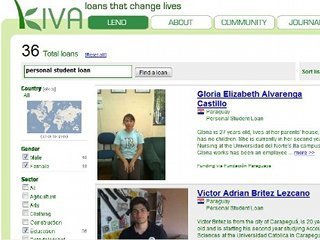

It’s hard enough for the average middle-class American student to pay for college, but for low-income students in developing nations, college is a near impossibility. For many, even basic elementary education is a difficult road to navigate. Kiva, a micro-lending organization for low-income entrepreneurs around the world, hopes to address that issue through its micro-lending program specifically for student loans, which was launched Monday.
The student loan program will work much the same way as the program for entrepreneurs. For a minimum of $25, Internet users can quickly and easily contribute to help cover an individual student’s educational expenses. Kiva is working with its Field Partners in Bolivia, Paraguay, and Lebanon to tailor loan offerings to the three countries’ students. As with other Kiva loans, a student loan can be tracked from the first payment all the way through to its repayment, at which point a lender can either withdraw his or her funds or loan to another student or entrepreneur to continue the lending cycle.
“Today, Kiva.org posted profiles for 36 students, seeking a total of $19,250.00. We are currently on track to fund all of those loans in full, within 12 hours of being posted on the site,” said Kiva president Premal Shah, in an email. “While this pilot is only a small step toward broadening access to student loan funding around the world, we plan to keep a close eye on the program’s success in an effort to expand the organization’s reach to a number of different countries and a larger group of students in need of funding.”
While the service certainly gives aspiring students an opportunity, the loan costs could be extravagant, if students are charged the same amount for their loans as entrepreneurs. And, not because Kiva charges any interest. Field partners working to distribute and collect funds in particular countries charge an average interest rate of 35% and upwards of 80%.
Entrepreneur roots
Founded in 2005 and launched in 2008, Kiva.org was created to address global poverty by providing a space where any individual Internet user from any economic background can loan as little as $25 to individual entrepreneurs around the world.
The organization’s goal is to encourage partner relationships between lenders and entrepreneurs, as opposed to benefactor relationships between donors and receivers. The business model, which holds entrepreneurs accountable for loan repayments, is specifically designed to promote entrepreneurship and business growth, thereby ushering low-income entrepreneurs into the global marketplace as opposed to providing a simple one-time donation.
Since its 2008 launch, over 477,000 Internet users have loaned more than $150 million in loans to 408,000 entrepreneurs in 53 countries. The organization boasts a 98% repayment rate, with loan payments made anywhere between one and three years. The average loan amount is $382 and one loan is faciliated every 10 seconds.
The student microloan program approaches the other side of the business development structure, which is education. The program enables students to develop the educational background necessary to help them become successful and competitive leaders in an increasingly global marketplace.
Unlike the general micro-lending program, the student microloan program does not focus exclusively on potential entrepreneurs, or individuals who have a business idea in mind, but rather — like U.S. student loans — is an investment in a student’s academic goals, which will allow them to find jobs and support their own communities.
“In developing countries, access to funding for education doesn’t exist like it does in the United States,” said Premal Shah, president of Kiva.org, in the organization’s press release. “Without being given the opportunity, students don’t have the chance to demonstrate fiscal responsibility. We believe the internet community is in a unique position to share the risk of student lending in the developing world.”
Now in the U.S.
In June 2009, Kiva expanded its program to bring microloans to U.S. entrepreneurs in response to the recession, which was leaving many small businesses in the dust and making it virtually impossible for many U.S. entrepreneurs to raise capital. The move was fiercely criticized by a group of 375 lenders calling itself “Unhappy Kiva Lenders,” (formerly the “Pissed Off Kiva Lenders”) which accused Kiva of undermining its very mission to address global poverty, as entrepreneurs in the United States are not living in true poverty. The group cited an example of a U.S. entrepreneur who had a college degree, a career in architecture, and was asking for $7000 to start his business—a sum that, if received, would have helped 7-10 entrepreneurs in the third world.
The Unhappy Kiva Lenders page has since been deleted from Kiva’s community of lending teams.
Kiva’s new student microloan program does not (as of yet) include U.S. students, but it will be interesting to see if the organization chooses to extend its microloan platform to low-income U.S. students as it did U.S. small business-owners.
Image source: kiva.org
















